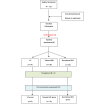Acceptability and preliminary feasibility of an internet/CD-ROM-based education and decision program for early-stage prostate cancer patients: randomized pilot study
- PMID: 22246148
- PMCID: PMC3846339
- DOI: 10.2196/jmir.1891
Acceptability and preliminary feasibility of an internet/CD-ROM-based education and decision program for early-stage prostate cancer patients: randomized pilot study
Abstract
Background: Prostate cancer is the most common cancer affecting men in the United States. Management options for localized disease exist, yet an evidence-based criterion standard for treatment still has to emerge. Although 5-year survival rates approach 98%, all treatment options carry the possibility for significant side effects, such as erectile dysfunction and urinary incontinence. It is therefore recommended that patients be actively involved in the treatment decision process. We have developed an Internet/CD-ROM-based multimedia Prostate Interactive Educational System (PIES) to enhance patients' treatment decision making. PIES virtually mirrors a health center to provide patients with information about prostate cancer and its treatment through an intuitive interface, using videos, animations, graphics, and texts.
Objectives: (1) To examine the acceptability and feasibility of the PIES intervention and to report preliminary outcomes of the program in a pilot trial among patients with a new prostate cancer diagnosis, and (2) to explore the potential impact of tailoring PIES treatment information to participants' information-seeking styles on study outcomes.
Methods: Participants (n = 72) were patients with newly diagnosed localized prostate cancer who had not made a treatment decision. Patients were randomly assigned to 3 experimental conditions: (1) control condition (providing information through standard National Cancer Institute brochures; 26%), and PIES (2) with tailoring (43%) and (3) without tailoring to a patient's information-seeking style (31%). Questionnaires were administrated before (t1) and immediately after the intervention (t2). Measurements include evaluation and acceptability of the PIES intervention, monitoring/blunting information-seeking style, psychological distress, and decision-related variables (eg, decisional confidence, feeling informed about prostate cancer and treatment, and treatment preference).
Results: The PIES program was well accepted by patients and did not interfere with the clinical routine. About 79% of eligible patients (72/91) completed the pre- and post-PIES intervention assessments. Patients in the PIES groups compared with those in the control condition were significantly more likely to report higher levels of confidence in their treatment choices, higher levels of helpfulness of the information they received in making a treatment decision, and that the information they received was emotionally reassuring. Patients in the PIES groups compared with those in the control condition were significantly less likely to need more information about treatment options, were less anxious about their treatment choices, and thought the information they received was clear (P < .05). Tailoring PIES information to information-seeking style was not related to decision-making variables.
Conclusions: This pilot study confirms that the implementation of PIES within a clinical practice is feasible and acceptable to patients with a recent diagnosis of prostate cancer. PIES improved key decision-making process variables and reduced the emotional impact of a difficult medical decision.
Conflict of interest statement
Conflicts of Interest: None declared.
Figures
Similar articles
-
Examining the impact of a multimedia intervention on treatment decision-making among newly diagnosed prostate cancer patients: results from a nationwide RCT.Transl Behav Med. 2018 Nov 21;8(6):876-886. doi: 10.1093/tbm/iby066. Transl Behav Med. 2018. PMID: 29982747 Free PMC article. Clinical Trial.
-
Health literacy and shared decision making for prostate cancer patients with low socioeconomic status.Cancer Invest. 2001;19(7):684-91. doi: 10.1081/cnv-100106143. Cancer Invest. 2001. PMID: 11577809
-
A Comprehensive 6-mo Prostate Cancer Patient Empowerment Program Decreases Psychological Distress Among Men Undergoing Curative Prostate Cancer Treatment: A Randomized Clinical Trial.Eur Urol. 2023 Jun;83(6):561-570. doi: 10.1016/j.eururo.2023.02.009. Epub 2023 Feb 22. Eur Urol. 2023. PMID: 36822969 Clinical Trial.
-
Systematic Review of Decision Aids for Newly Diagnosed Patients with Prostate Cancer Making Treatment Decisions.J Urol. 2015 Nov;194(5):1247-52. doi: 10.1016/j.juro.2015.05.093. Epub 2015 Jun 6. J Urol. 2015. PMID: 26055824
-
A systematic review of the feasibility, acceptability, and efficacy of online supportive care interventions targeting men with a history of prostate cancer.J Cancer Surviv. 2019 Feb;13(1):75-96. doi: 10.1007/s11764-018-0729-1. Epub 2019 Jan 4. J Cancer Surviv. 2019. PMID: 30610736 Free PMC article.
Cited by
-
A Mobile Patient-Facing App for Tracking Patient-Reported Outcomes in Head and Neck Cancer Survivors: Single-Arm Feasibility Study.JMIR Form Res. 2021 Mar 19;5(3):e24667. doi: 10.2196/24667. JMIR Form Res. 2021. PMID: 33739291 Free PMC article.
-
Examining the impact of a multimedia intervention on treatment decision-making among newly diagnosed prostate cancer patients: results from a nationwide RCT.Transl Behav Med. 2018 Nov 21;8(6):876-886. doi: 10.1093/tbm/iby066. Transl Behav Med. 2018. PMID: 29982747 Free PMC article. Clinical Trial.
-
Preference Elicitation and Treatment Decision-Making Among Men Diagnosed With Prostate Cancer: Randomized Controlled Trial Results of Healium.J Med Internet Res. 2023 Oct 20;25:e46552. doi: 10.2196/46552. J Med Internet Res. 2023. PMID: 37862103 Free PMC article. Clinical Trial.
-
PRE-VIEW: Development and Pilot Testing of An Interactive Video Doctor Plus Provider Alert to Increase Cancer Screening.ISRN Prev Med. 2013;2013:935487. doi: 10.5402/2013/935487. ISRN Prev Med. 2013. PMID: 24409373 Free PMC article.
-
Decision aids for people facing health treatment or screening decisions.Cochrane Database Syst Rev. 2017 Apr 12;4(4):CD001431. doi: 10.1002/14651858.CD001431.pub5. Cochrane Database Syst Rev. 2017. Update in: Cochrane Database Syst Rev. 2024 Jan 29;1:CD001431. doi: 10.1002/14651858.CD001431.pub6. PMID: 28402085 Free PMC article. Updated.
References
-
- National Cancer Institute. 2011. [2011-06-20]. Prostate Cancer http://www.cancer.gov/cancertopics/types/prostate.
-
- Logothetis CJ, Millikan R. Update: NCCN practice guidelines for the treatment of prostate cancer. Oncology (Williston Park) 1999;13(11A):118–32.
-
- Bahnson RR, Hanks GE, Huben RP, Kantoff P, Kozlowski JM, Kuettel M, Lange PH, Logothetis C, Pow-Sang JM, Roach M, Sandler H, Scardino PT, Taylor RJ, Urban DA, Walsh PC, Wilson TG, National Comprehensive Cancer Network NCCN Practice Guidelines for Prostate Cancer. Oncology (Williston Park) 2000 Nov;14(11A):111–9. - PubMed
-
- Litwin MS, Gore JL, Kwan L, Brandeis JM, Lee SP, Withers HR, Reiter RE. Quality of life after surgery, external beam irradiation, or brachytherapy for early-stage prostate cancer. Cancer. 2007 Jun 1;109(11):2239–47. doi: 10.1002/cncr.22676. http://dx.doi.org/10.1002/cncr.22676 - DOI - DOI - PubMed
Publication types
MeSH terms
Grants and funding
LinkOut - more resources
Full Text Sources
Medical


